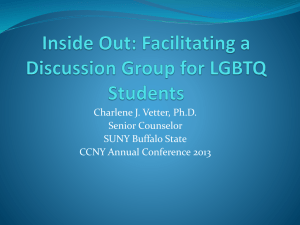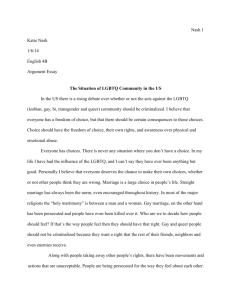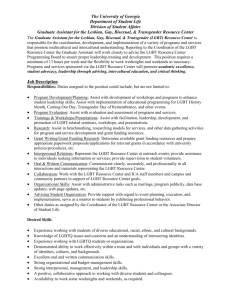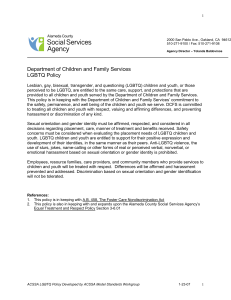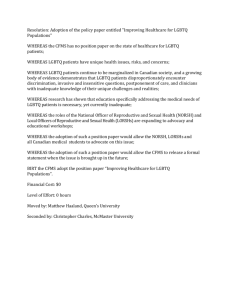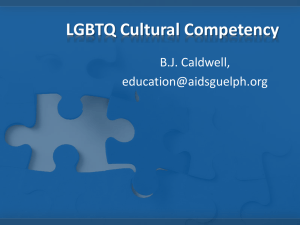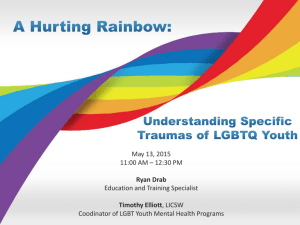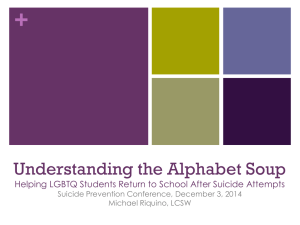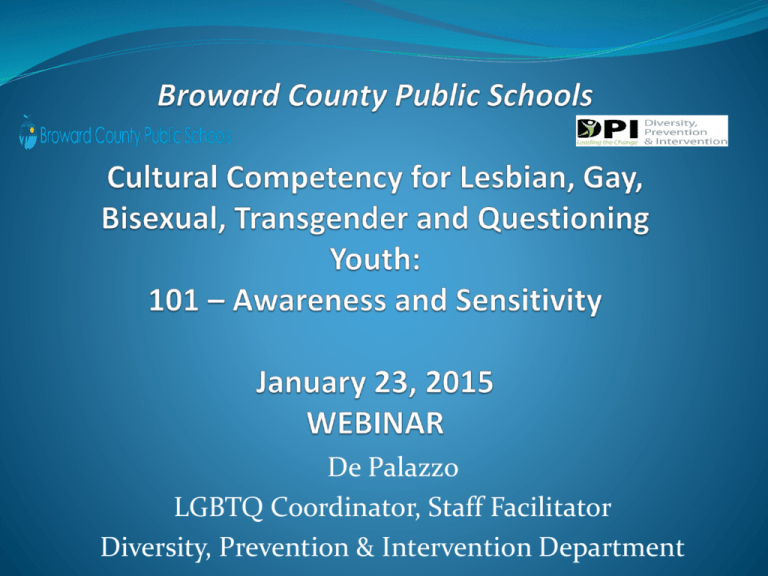
De Palazzo
LGBTQ Coordinator, Staff Facilitator
Diversity, Prevention & Intervention Department
Goal
To raise awareness and provide introductory information
about lesbian, gay, bisexual, transgender and questioning
youth as a population, as well as the psycho-social
dynamics related to being a young person who identifies
as LGBTQ
Our Agenda for Today
Beginning with Oneself
Emerging Issues, Needs and Challenges for
LGBTQ Youth ~ Nationally and Locally
Our LGBTQ Homeless Youth
The Paradigm of Sexuality
Family Challenges: Rejecting, Ambivalent,
Accepting?
Resources and Terminology
What, So What, Now What?
What?
What are the unique challenges LGBTQ and gender
nonconforming youth face, and why?
How do these challenges relate to LGBTQ youth in Broward
County Schools elementary, middle and high schools?
So What?
How do I help to ensure support and foster resiliency for
LGBTQ and gender nonconforming students?
How can my present role enhance respectful and inclusive
climates at my within my school community?
What, So What, Now What?
Now What?
What have I been reminded of, or what have I learned that
will ensure deeper sensitivity and awareness toward LGBTQ
and gender nonconforming students?
Bring harmony to this world, one at a time, one
at a time it will work---with a teacher, a
parent…it will work. I know that it will.
It has to.”
- Jamesly Louis, 19 year old South Florida youth
of Haitian identity
Group Agreements: PROCESS
P - Participate, pass
R - Respect (one another’s ideas and comments)
O - Open and honest communication
C - Confidentiality
E - Experiment with new ideas/challenge established
assumptions
S - Step forward/step back
S - Seek to understand - or agree to disagree
Latin derivative for respect: Respeto
To create space for physically, mentally, emotionally and spiritually
As humans being…
Glasser reminds us…
Sense that we belong
Respect
A sense of recognition
Work
background
Gender
Race
Learning
style
Age
Education
Geographic
location
Religion
Dimensions
of
Diversity
Appearance
Class: socioeconomic
Ability
Language
Ethnicity
Sexual
Orientation
Emerging Issues…
Societal shifts regarding the recognition and/or acceptance of
LGBTQ people
United States government has issued a “call to action”
regarding the safety of LGBTQ youth in our schools
Biased language
Personal experiences of harassment and assault
The emergence of gender nonconforming and transgender
youth
Students coming out younger (and bolder)
Significant increase in Gay Straight Alliance (GSA) Clubs across
the country
Strengthening ALL Students’
Success Trajectory
In pursuit of becoming well-rounded individuals, both
academic success as well a social-emotional needs
High quality instruction---college or career ready
Proficient 21st century critical thinking, world class citizens
Reduce and eliminate achievement gaps
Overall:
Stability and opportunities for exemplary, positive youth
development
BCPS inclusive and culturally competent services offered to
enable LGBTQ and gender nonconforming youth to SOAR
Intersections, stressors, identity…
Intersection of societal challenges and “isms”
How do issues of race, ethnicity, economics, gender,
language, etc. intersect with a student’s LGBTQ
identity?
Minority Stress… related to stigmatization, societal
attitudes—correlation to explicit and implicit bias,
etc.
Our Charge, as Professionals
As professionals, it is our legal, ethical and professional
expectation that all our youth - from varying identities,
cultures, backgrounds, life experiences, abilities,
languages and beliefs - be given exemplary inclusive and
culturally competent services to help ensure their
physical, mental and emotional well-being, and to help
ensure stability in their lives
Three Pillars of Social Support
for Personal Identity
Family
Place of worship
School
Our professional and
ethical obligation to
ensure the safety, respect
and value for ALL youth, in
particular marginalized
youth with barrier
intersections
Issues Facing LGBTQ Youth
Common Reasons for harassment
in schools
Source:
From Teasing to Torment: School Climate in America,
A Survey of Students and Teachers
Bias Based Language in
Today’s Schools
Homophobic remarks are the most common type of
biased language heard at school:
Approximately 72% (seven out of ten) of students hear
“that’s so gay” or ”you’re so gay” frequently.
Approximately two thirds of students hear other
homophobic remarks (e.g., “dyke” or “faggot”)
frequently.
53% (one in two) hear homophobic remarks from
teachers or other school staff.
Source: 2013 GLSEN School Climate Survey-8400 mid and high school students
Personal Experiences of
Harassment and Assault in Schools
Sexual orientation and gender expression were the most
commonly targeted characteristics:
Sexual Orientation
Almost Two thirds of students had been verbally
harassed, almost a third physically harassed, and nearly a
fifth (18%) physically assaulted in the past year.
Nearly one third of LGBT youth skipped at least one day of
school in the past month because of safety concerns
Gender Expression
Just under half had been verbally harassed, a quarter
(26%) physically harassed, and 12% physically assaulted in the
past year.
Source: 2013 GLSEN School Climate Survey, 8400 mid and high school youth
A Qualitative Survey-50 LGBTQ
Students, Broward County, Florida
Is it accepted by your
parent/guardian?
Have you ever left your house, stayed
at someone’s or been told to leave
your home due to tension because of
your orientation, gender identity or
expression?
If you asked for help at school
related to LGBTQ needs, were you
ever given pamphlets, palm cards,
etc. that had support or outreach
info on it?
Yes, it’s satisfactory: 63%
Yes, minimally supported: 21%
Not at all supported: 15%
Yes: 32%
No: 68%
Yes: 19%
No: 23%
Did not ask for assistance: 58%
Surgeon General’s Report
The 2012 National
Strategy for Suicide
Prevention
At a Higher Risk for Suicide…
A meta-analysis of adolescent studies concluded that LGB
youth were three times more likely to report a lifetime
suicide attempt than heterosexual youth, and four times
as likely to make a medically serious attempt.
Across studies, at least 30 percent of LGB adolescents
report attempts, compared with 8 to 10 percent of all
adolescents.
HRC 2012 Study of 10K LGBT Youth
LGBT, when asked to describe
the most important problem
now…
Non-LGBT, when asked to
describe the most important
problem now…
Non-accepting Families
Classes/exams/grades
School Bullying
College/career
Fear of being out or open
Financial pressures related
Understanding non-
tolerance and hate
Where I live/who I live with
to college or jobs
Yet…
An analysis of fourteen (14) years of data finds little
change in LGBT youth harassment in schools, with
LGBT students’ experiences with more severe forms
of bullying and harassment remaining relatively
constant, with a slight drop in mistreatment.
Source: GLSEN School Climate Survey 2013 (1999-2013)
So What?
Loss of Support
Fear of Harassment
and
and Invisibility
Rejection from Key Relationships
Major Barriers
This---Contributes to internal
conflict…
How Do I Manage a Stigmatized
Identity?
Identity and Conflict at Home…
Between 20-40 per cent of all homeless students identify as
LGBTQ
Most LGBTQ students become homeless because of conflict over
their identity, family abuse, or family neglect
Two-thirds (66%) of 400 LGBTQ homeless youth reported having
been in a child welfare placement in the past
LGBT homeless students are more likely to attempt suicide (62%)
than their heterosexual homeless peers (29%).
Van Leeuwen, Boyle, Salomonsen-Sautel, Baker, Garcia 2006
Research has shown that LGBTQ students, and particularly youth
who have left home due to conflict over their sexual identity, are
more likely than their heterosexual peers to be at risk for
substance use, sexual behaviors that lead to HIV infection and
other sexually transmitted infections, and attempted suicide
CDC 2009, Ryan 2009, Van Leeuwen, Boyle, Salomonsen-Sautel, Baker, Garcia 2006
Our transgender youth…
Transgender youth – particularly
misunderstood in general
Transgender youth are regularly
targeted for harassment and
assaults
are not offered appropriate
resources
are expected to use the
restroom that is incongruent
with their core gender identity
called by their names assigned at
birth rather than preferred
names
expected to be incongruent in
dress/gender expression from
their gender identity
Mean Age of Coming Out
Researchers have observed that the average age of sexual
attraction is about age 10 for both heterosexual and LGBT
)
identified youth (McClintock & Herdt
Responses to Coming Out
Recognize the importance of this process for the LGBTQ
student. Recognize the choice to tell YOU.
Respect the risk the child is taking by coming out to you and
assure confidentiality.
Show your appreciation and support of her/him.
Help to make it a happy occasion. (Smile and relax!)
Listen, listen, listen - and listen some more.
Be prepared to give resources for emotional support, if the
youth so desires.
Also - remember to never out a young person to parents,
caregivers, guardians or others due to possible severe
ramifications for the youth.
“In school, we know who to go to, we know who not to go to.”
Alex, 17 year old student
What Not to Say…
I knew it!
Are you sure?
Are you confused?
Is this just a phase?
You just haven’t found the right woman/man.
Shhhh, don’t tell anyone.
You can’t be gay, you’ve had relationships with people of
the opposite sex.
You know I need to tell someone else (parent, leadership,
etc.) about this in order to keep you safe.
Paradigm of Human Sexuality
Sexual
Behavior
Gender
Role
Sexual
Orientation
Gender
Identity
Sexual Behavior
Sexual behavior is a choice.
Behaving homosexually does not necessarily mean that one’s
sexual orientation is homosexual.
Likewise behaving heterosexually does not necessarily mean
that one is heterosexual.
Significant numbers of people have engaged in both
heterosexual and homosexual behavior.
Sexual Orientation
Sexual orientation seems to be formed at a very early age.
Adolescence and early adulthood are an unfolding of that
orientation.
The development of sexual orientation does not seem to be a
choice.
Gender Identity
Gender identity is the core “within” sense of “I am male” or “I
am female.”
Formed at a very early age and not subject to choice.
Gender identity is revealed by feelings, dreams and fantasies
about one’s body, one’s core self and genitals.
Gender Role
Gender role most often reflects the ways in which our culture
invites us to behave depending on our genitals.
Gender role is similar to sexual behavior in that it is a choice.
“Be a man”
“Act like a lady”
Comment to a middle school boy who was not portraying
typical gender role cueing:
“What the heck, ________!! Sit like a man, would you
please?”
Several others chime in humiliatingly with agreement.
Numerous others laugh. (Incident in Broward Middle School
summer camp program.)
Families: A Unique Challenge for
LGBT Students and Relatives
Families: A Unique Challenge for
LGBT Youth and Relatives
LGBT youth who reported high levels of family rejection during
middle and high school were:
Approximately eight times more likely to reporting to have
attempted suicide.
Almost six times more likely to report high levels of
depression.
Three and a half times more likely to use illegal drugs.
Three and a half times more likely to have engaged in
unprotected sex.
(Ryan, et al., 2009)
“Darnell came up to me and said ‘Mommy, I like boys.” At first I
didn’t pay much attention. I wasn’t sure what he meant. A
couple of weeks later, he said it again: ‘I like boys. You know,
like you like Daddy.’ I said “Darnell, we’re going to read
Scripture.’ So I picked up the Bible and read him a passage.
I did that every time he tried to talk with me, and then I
realized that his eyes were just looking off. He didn’t
understand what I was saying, but he knew I wasn’t listening.
So then I asked him to talk with me and tell me what he felt. I
was really afraid of what he was saying but he is my little boy.
And I love him.”
Keisha, mother of 7 year old son Darnell
Leading with Love…
Family behaviors that INcrease an LGBTQ child’s
risk for health and mental health problems
Hitting, slapping or physically hurting your child because of their
LGBT identity
Verbal harassment or name-calling because of your child’s LGBT
identity
Excluding LGBT youth from family and family activities
Blocking access to LGBT friends, events and resources
Blaming your child when they are discriminated against bc of their
identity
Pressuring your child to be more (or less) masculine or feminine
Telling your child that God will punish them because they are gay
Telling your child that you are ashamed of them, or how they look
or act will shame the family
Making your child keep their LGBT identity a secret in the family
and not letting them talk about it
Caitlin Ryan, Family Acceptance Project, 2010
Family behaviors that REDUCE an LGBT
child’s risk for health and mental health
problems and promote their well-being
Talk with your child or foster child about their LGBT identity
Express affection when your child tells you or when you learn that your
child is gay or transgender
Support your child’s LGBT identity even though you may feel
uncomfortable
Advocate for your child when s/he is mistreated bc of their LGBT identity
Require that other family members respect your LGBT child
Bring your child to LGBT orgs or events
Talk with clergy and help your faith community to support LGBT people
Connect your child with an LGBT adult role model to show them options
for the future
Welcome your child’s LGBT friends or partners to your home.
Support your child’s gender expression
Believe your child can have a happy future as an LGBT adult
Caitlin Ryan, Family Acceptance Project, 2010
Family’s Acceptance…
Now What?
Designing Respect and Inclusivity
for All Schools
Safety ‘markers” and safety “actions”
Visibility
Post Safe Space stickers and/or
Posters
Display LGBT Supportive
Materials
Make Yourself a Visible Marker
as an Ally
Let Other Educators Know You
Are an Ally
Actions
Make No Assumptions
Use Inclusive Language
Respond to Anti-LGBT behavior
What are “best practice” and culturally
competent school community skills and actions
that will enable LGBTQ and gender
nonconforming students to stabilize their lives?
What are YOUR Local LGBTQ Resources and Organizations?
Broward County Public Schools Department of Diversity, Prevention & Intervention
www.browardprevention.com
Tab, Diversity, tab LGBTQ
See “ LGBTQ Health and Safety Critical Support Guide” for many district and community resources,
updated summer 2014
Broward County Public Schools Student Services Department
www.browardstudentservices.com
SunServe (www.sunserve.org)
Rap Groups, Education and Outreach Programs for Youth
Counseling and Psychotherapy Programs for Youth and Adults
Family and Youth Programs
YES Institute
www.yesinstitute.org
An excellent knowledge source on gender and orientation
New satellite office in Broward County
PFLAG
www.pflag.org
Parents, Families & Friends of Lesbians & Gays
Helps families and friends who struggle with LGBTQ issues
Local meetings held monthly
A Community Organization Educating
about LGBTQ Needs and Resilency
Our Next One Hour Webinar:
LGBTQ 201—Going Deeper
What skills, toolkits and systems of support do we need to create
inclusive classrooms and school communities that ensure safety,
support and inclusivity for students who are LGBTQ?
What are BCPS policies, as well as state and federal policies and
guidelines as it pertains to the rights, safety and support of LGBTQ
students, including but not limited to “out” students, proms, and
students who identify as transgender?
When an LGBTQ student is in need, what are the correct channels
of support to utilize at your school site so the child receives
appropriate help, prevention or intervention?
How does a school staff person intervene on the spot when LGBTQ
exclusion, harassment or mistreatment take place?
THANK YOU for your passion, time, and
commitment as we ensure-together-that all
BCPS students are safe, valued, connected
and respected in every elementary, middle
and high school in our county!
For school-based or individual questions or
consultation, please contact:
De Palazzo
Department of Diversity, Prevention & Intervention, BCPS
Denise.palazzo@browardschools.com
754.321.1634
We are here for you!

